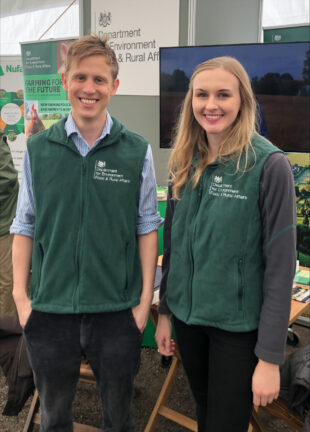https://defrafarming.blog.gov.uk/manage-historic-features-in-grassland/
Manage historic features in grassland
The guidance on this page is for SFI pilot participants only. Please visit GOV.UK for the official Sustainable Farming Incentive scheme guidance.
Find out how land managers can manage historic features, and conserve landscape character and cultural heritage.
If you’re completing this action as part of the Sustainable Farming Incentive pilot, how you do it is up to you.
The advice on this page can help you get better environmental and business benefits, but you do not have to follow it to get paid.
About historic features in grassland
Historic features can be found throughout England, with many in grassland settings.
Historic features above ground include earthworks like:
- hollows and humps
- banks and ditches
Historic features found below ground can include:
- buried evidence of past human activity like pottery and bone
- cave-like structures like souterrains
- waterlogged deposits like peat that contain evidence of past climate (paleoecology)
If you have permanent grassland, you can protect historic features and structures by maintaining a cover of grassland or other shallow rooting plants. This helps minimise ground disturbance, which can damage or displace features.
Register and request an SFI Historic Environment Farm Environment Record (SFI HEFER) to learn more about historic features on your land.
Importance of historic features
Historic features link people with their history and ancestors.
Managing historic features can:
- preserve our cultural heritage for future generations
- help us learn about the past
- conserve the character of the landscape
- provide educational opportunities
- remove designated historic features from the heritage at risk register
How to manage historic features in grassland
To maintain the grass you can graze with livestock or cut it. You must not damage the historic features. Graze or cut often enough to avoid scrub growth.
To support grazing you may need capital items like fencing, gates and troughs. Read about how to apply for grants for capital items. You must find out if you need consent to install these items on a scheduled monument.
If your land is part of a Site of Special Scientific Interest (SSSI), you must find out if you need consent for work before you start.
Grazing grassland
Use livestock to maintain grass at a height which allows the features to be seen.
Manage livestock to avoid:
- overgrazing, which can cause erosion or bare patches
- undergrazing, which can cause scrub to develop
Grazing with smaller and lighter livestock like sheep can reduce the chances of damage to earthworks. This can minimise harm on steep slopes or wetter soils.
To avoid poaching and erosion you can:
- reduce livestock numbers or use lighter animals like sheep
- manage the way livestock move around historic features by relocating gates or water troughs
- remove heavier livestock like cattle in the winter
You must not supplementary feed livestock on historic features.
Most livestock will use historic structures as rubbing points. You can install fencing around the feature to protect it.
Find out more about livestock grazing.
Cutting grassland
If you manage grassland by mowing or strimming, make sure that the ground does not become compacted.
To minimise damage to the feature, you should not:
- cut when the ground is too wet
- use flail mowers
- clip features by mowing too close
- mow on steep earthworks
Choose higher cutting heights to avoid scalping. Where possible mow at right-angles on linear earthworks, rather than following the feature.
Reseeding
You’ll need to reseed bare areas to protect the historic features.
Choose a tough variety of grass in places where public access is high. Do not re-seed species-rich grassland as the grasses will outcompete flowers and finer grasses. You can spread freshly cut hay from local wildflower-rich sites on these areas.
Do not use a disc or power harrow as these will cause damage. Avoid rolling the ground.
To avoid disturbing the feature you can:
- use minimal cultivation methods like direct drilling and seed slotting
- broadcast (scatter) seed by hand or use a light machine
- spread freshly cut hay
You must find out if you need consent if you want to do this on a scheduled monument.
Adding manure and fertiliser
You can apply manure or fertiliser. You need to avoid causing damage with the machinery you use.
You must follow the farming rules for water. These require you to take steps to stop manure, fertiliser or soil getting into waterbodies.
You should keep manure heaps away from historic features as these can create bare patches when removed and encourage weeds. Runoff from stored manure can damage buried historic features.
To conserve species-rich grassland, do not add nutrient inputs unless you’re taking a hay crop.
Managing plants and scrub on historic features
You need to stop plants with deep roots from growing as they can damage underground archaeology. These include:
- bracken
- nettles
- Japanese knotweed
- scrub and trees
To prevent damage to historic features you can:
- control vegetation with hand tools and chemicals, not mechanical cutting or crushing
- apply chemicals on foot or use light machinery, to avoid ground compaction and disturbance
- cut and treat stems, rather than uproot or dig out plants
- re-establish grass cover after you remove vegetation, to help discourage undesirable plants
Where you can, remove scrub or trees to prevent damage to the feature. You normally need a felling licence from the Forestry Commission before you can fell growing trees. Find out how to prepare to fell trees or how to apply for permission.
How to protect historic features in grassland
Surface erosion
Surface erosion can be caused by:
- livestock
- visitors
- machinery
You can place signs and maps to encourage visitors to stay on less sensitive parts of the site.
Vehicles can cause bare ground, ruts and soil compaction, damaging underground remains or altering the shape of historic features. Make sure that contractors, workers and visitors know where they can take vehicles without causing damage.
Ground disturbance
Tunnelling animals like rabbits can disturb underground remains and cause historic features and buildings to subside. You can manage and control them to help protect the feature.
Works like laying cables, installing drainage systems or fencing can disturb the ground and damage features. To avoid this, you can:
- provide workers with a map of the features, so they can avoid sensitive areas
- re-use existing post holes when replacing fencing
- keep new drainage away from the historic feature
Metal detecting
You must not allow metal detecting on scheduled monuments on your land, unless you have consent. Ask the Rural Payments Agency whether you need permission to allow metal detecting on other known archaeological sites on your land. Any metal detecting you allow on your land should follow the Portable Antiquities Scheme best practice.
How you’ll know if you’ve been successful
You’ll see:
- the shape of any earthworks under the grass
- undisturbed grassland or dwarf shrubs with no woody scrub
- full cover of grassland with few bare patches, ruts or new tracks
- few signs of burrowing animals, like holes or disturbed soil
- any feeding or watering equipment located away from the feature


